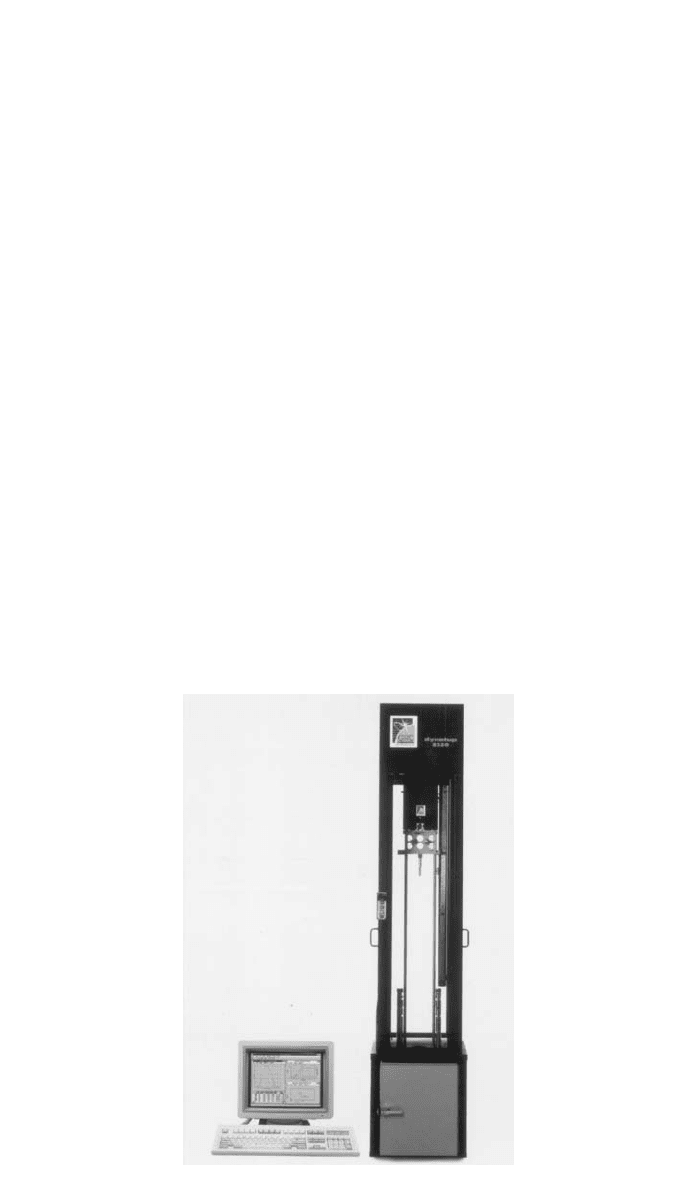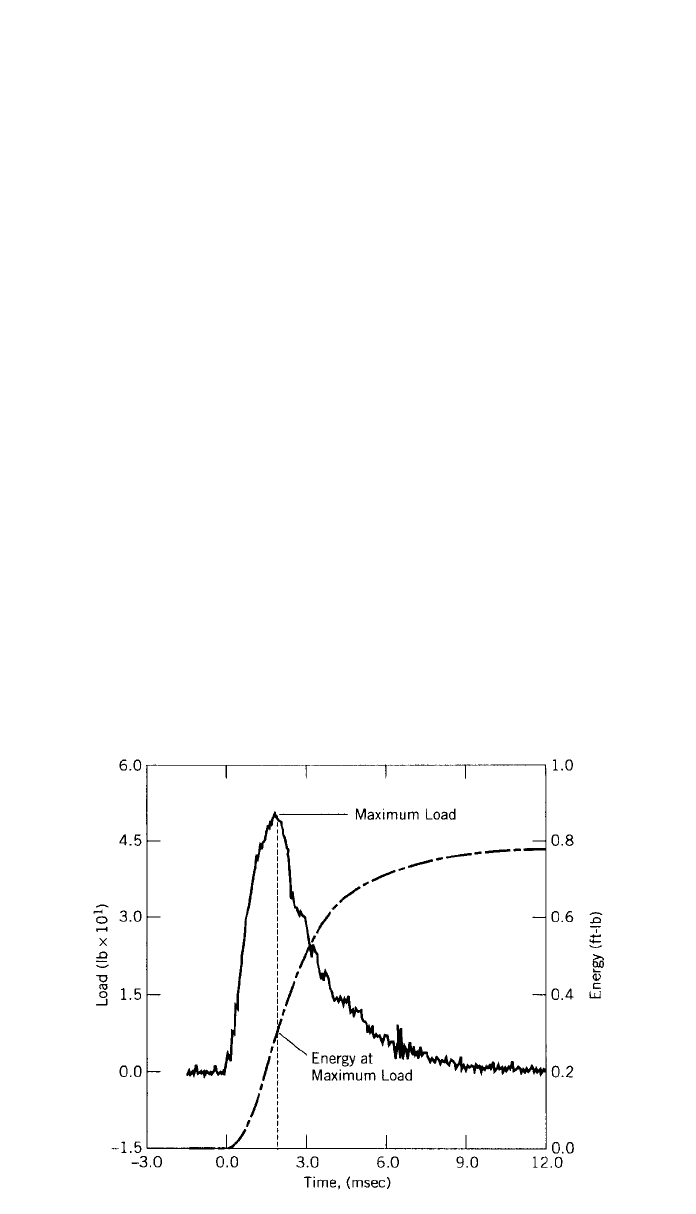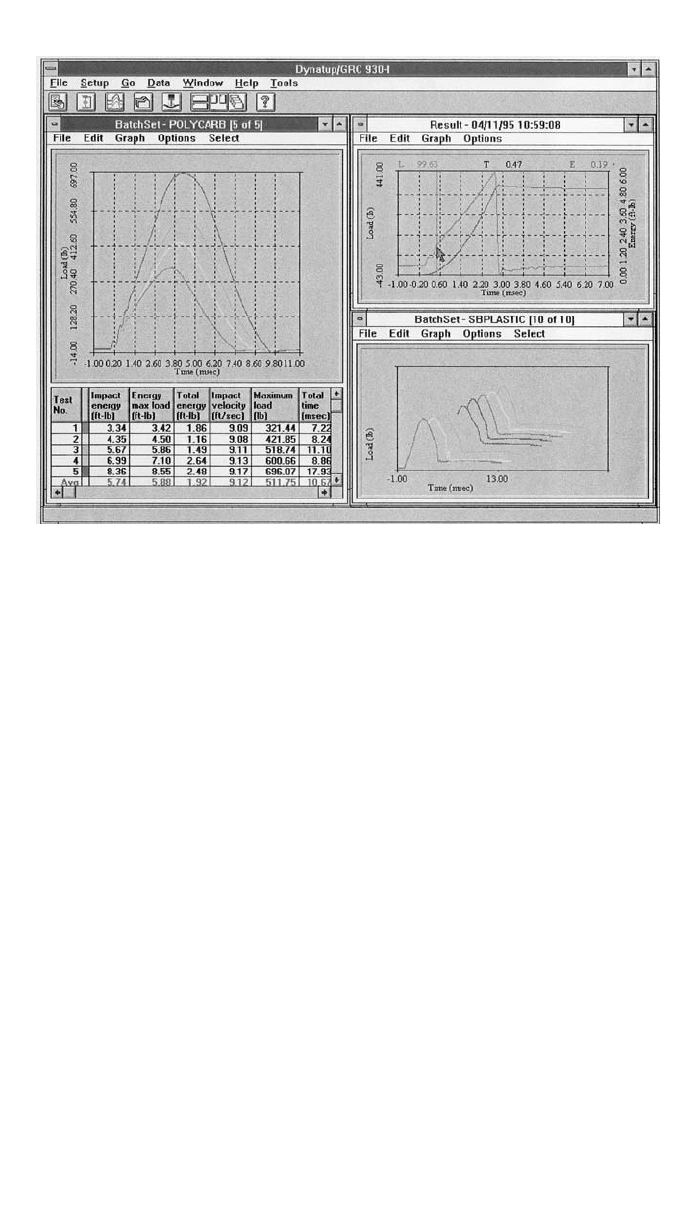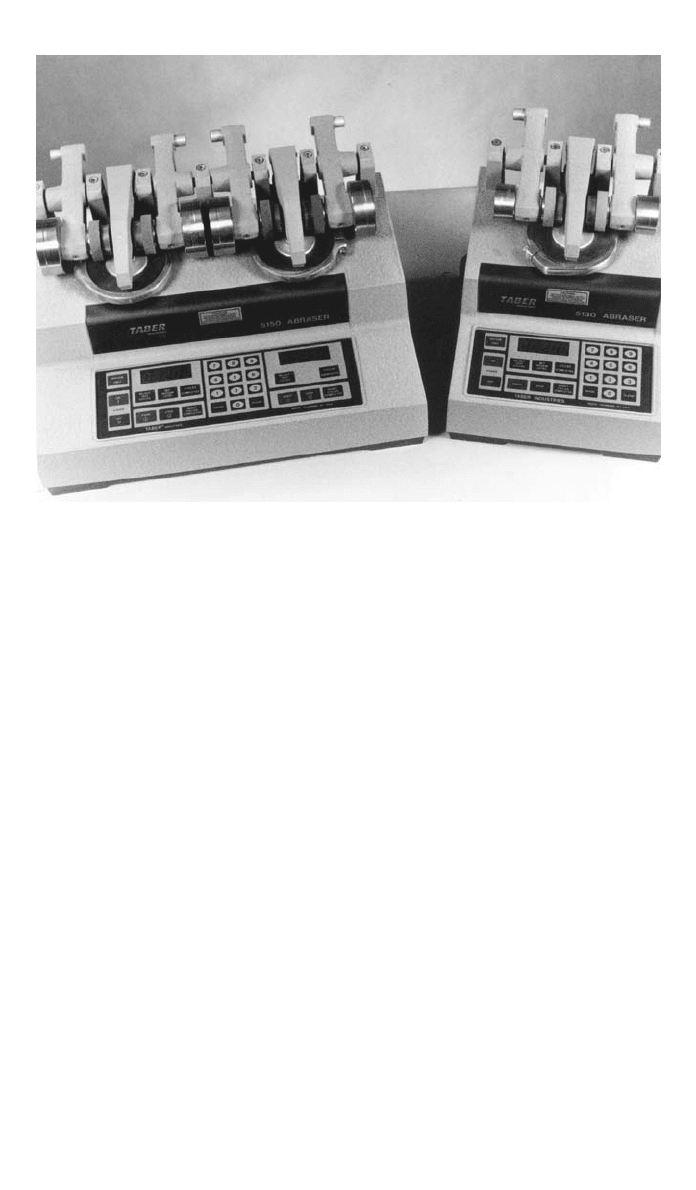Kutz M. Handbook of materials selection
Подождите немного. Документ загружается.


558 PLASTICS TESTING
Fig. 8 Pendulum impact tester. (Courtesy Tinius Olsen Company)
The energy required to fail the specimen is measured by dropping a known
weight from a known height onto a test specimen. The impact energy is normally
expressed in ft-lb and is calculated by multiplying the weight of the projectile
by the drop height.
The biggest advantage of the falling-weight impact test over the pendulum
impact test or high-rate tension test is its ability to duplicate the multidirectional
impact stresses that a part would be subjected to in actual service. The other
obvious advantage is the flexibility to use specimens of different sizes and
shapes, including an actual part. Unlike the notched Izod impact test, which
measures the notch sensitivity of the material and not the material toughness,
falling-weight impact tests introduce polyaxial stresses into the specimen and
measure the toughness. The variations in the test results due to the fillers and
reinforcements, clamping pressure, and material orientation are virtually elimi-
nated in the falling-weight impact test. This type of test is also very suitable for
determining the impact resistance of plastic films, sheets, and laminated mate-
rials.
Three basic ASTM tests are commonly used depending upon the application:

1 MECHANICAL PROPERTIES 559
Fig. 9 Drop impact tester. (Courtesy Byk-Gardner USA)
ASTM D5420. Impact resistance of flat rigid plastic specimen by means of
a falling weight
ASTM D1709. Impact resistance of plastic film by the free-falling dart
method
ASTM D2444. Test for impact resistance of thermo-plastic pipe and fittings
by means of a tup
Drop Impact Test. This falling-weight impact test is primarily designed to
determine the relative ranking of materials according to the energy required to
break flat rigid plastic specimens under various conditions of impact of a striker
impacted by a falling weight. A free-falling weight, or a tup, is used to determine
the impact resistance of the material.
Many different versions of test equipment exist today. They all basically op-
erate on the same principle. Figure 9 illustrates one such typical commercially
available testing machine. It consists of a cast aluminum base, a slotted vertical
guide tube, a round-nose striker and striker holder, an 8-lb weight, a die and die

560 PLASTICS TESTING
support, and a sample platform. The sample platform is used to position a sheet
of desired thickness for impact testing. The die is removable from the base in
order that the actual parts of complex shapes can be placed onto the base and
impact tested.
The test is carried out by raising the weight to a desired height manually or
automatically with the use of a motor-driven mechanism and allowing it to fall
freely onto the other side of the striker. The striker transfers the impact energy
to the flat test specimen positioned on a cylindrical die or a part lying on the
base of the machine. The kinetic energy possessed by the falling weight at the
instant of impact is equal to the energy used to raise the weight to the height
of the drop and is the potential energy possessed by the weight as it is released.
Since the potential energy is expressed as the product of weight and height, the
guide tube can be marked with a linear scale representing the impact range of
the instrument in in.-lb. Thus, the toughness or the impact resistance of a spec-
imen or a part can be read directly off the calibrated scale in in.-lb. The energy
loss due to the friction in the tube or due to the momentary acceleration of the
punch is negligible.
An alternate method for achieving the same result utilizes an instrument that
employs a free-falling dart dropped from a specified height onto a test specimen.
The dart with a hemispherical head is constructed of smooth, polished aluminum
or stainless steel. An electromagnetic, air-operated or other mechanical release
mechanism with a centering device is used for releasing the dart. The dart is
also fitted with a shaft long enough to accommodate removable incremental
weights. A two-piece annular specimen clamp is used to hold the specimen.
Instrumented Impact Testing. One of the biggest drawbacks of the conven-
tional impact test methods is that it provides only one value—the total impact
energy—and nothing else. The conventional tests cannot provide additional in-
formation on the ductility, dynamic toughness, fracture, and yield loads or the
behavior of the specimen during the entire impact event.
This effectively limits the application of noninstrumented impact test methods
to quality control and material ranking. Instrumented impact testers are generally
suited for research and development as well as advance quality control.
Instrumented impact testers measure force continuously while the specimen
is penetrated. The resulting data can be used to determine type of failure and
maximum load, in addition to the amount of energy required to fracture the
specimen. One of the most common type of failures occurring from ductile to
brittle transition at low temperatures can only be observed by studying the load–
energy–time curve. The fracture mode of a plastic is sensitive to the changes in
temperature, and can change abruptly at or near the materials transition temper-
ature. Manufacturers of plastic automotive components routinely test materials
at low temperatures (
⫺20 to ⫺40⬚F) to assure that they will not become brittle
in cold weather. By studying the shape of the load–time or load–deflection
curve, the type of failure can be analyzed, and important information about its
performance in service can be gathered. The new piezoelectric-equipped strikers
offer increased sensitivity, opening the doors for testing a whole new range of
materials. Applications involving light-weight products such as foam containers
for eggs and ultra-thin films used in packaging industry can now be meaningfully
tested.

1 MECHANICAL PROPERTIES 561
Fig. 10 Instrumented impact tester. (Courtesy Instron Corporation)
All standard impact testers can be instrumented to provide a complete load
and energy history of the specimen. Such a system monitors and precisely re-
cords the entire impact event, starting from the acceleration (from rest) to the
initial impact and plastic bending to fracture initiation and propagation to the
complete failure. The instrumentation is done by mounting the strain gauges or
load cell onto the striking bit in the case of pendulum impact tester or onto the
tup in the case of a drop impact tester. During the test, a fiber-optic device
triggers an oscilloscope just before striking the specimen. The output of the
strain gauge is recorded by the oscilloscope depicting the variation of the load
applied to the specimen throughout the entire fracturing process. A complete
load–time history of the entire specimen is obtained. The apparent total energy
absorbed by the specimen can be calculated and plotted against time. The spec-
imen displacement can be calculated by the double integration of the load–time
curve and the load–displacement curve can be plotted. With the advent of mi-
croprocessor technology, some manufacturers are now capable of offering a unit
that automatically calculates the sample displacement and provides a load–
displacement curve eliminating the need for calculations. Many other useful data
such as the impact rate, force and displacement at yield, and break, yield, and
failure energies as well as modulus are calculated and printed out. A commer-
cially available instrumented impact tester is shown in Fig. 10.
Interpreting Impact Data
Modern instrumented impact test machines generate a complete record of (1)
force applied to the specimen versus time, (2) displacement of the impactor

562 PLASTICS TESTING
Fig. 11 Load–energy–time curve showing effect of impact on a specimen.
(from the point of specimen contact) versus time, (3) velocity of the impactor
versus time, and (4) energy absorbed by the specimen versus time.
When plotted (Fig. 11), many details of the impact event become clearly
visible in the data. Most systems also analyze the data and provide tabulated
reports of critical values. Results of instrumented impact tests are interpreted
differently depending on the type of material being tested and the failure criteria
applied.
For homogeneous materials, four values are critical:
Maximum (yield) load is simply the highest point on the load–time curve.
Often the point of maximum load corresponds to the onset of material
damage or complete failure.
Energy to maximum (yield) load is the energy absorbed by the specimen up
to the point of maximum load. When maximum load corresponds to failure,
the energy to max load is the amount of energy the specimen can absorb
before failing.
Total energy is the amount of energy the specimen absorbed during the com-
plete test. This number may be the same as energy to maximum load when
the specimen abruptly fails at the maximum load point.
Deflection to maximum (yield ) load is the distance the impactor traveled from
the point of impact to the point of maximum load. Figure 12 shows a
typical test data.
High-Speed Impact Tests (ASTM D3763, ISO 6603-2). An ever-increasing
demand for engineering plastics and the need for sophisticated and meaningful
impact test methods for characterizing these materials have forced the industry
into developing new high-speed impact tests. These tests not only provide the

1 MECHANICAL PROPERTIES 563
Fig. 12 Typical test data obtained with instrumented impact tester.
(Courtesy Instron Corporation)
basic information regarding the toughness of the polymeric materials but also
provide other important data of interest, such as the load–deflection curve and
the total energy absorption. The high-speed impact test overcomes the basic
limitations of conventional impact testing methods as discussed previously. The
rate of impact can be varied from 30 to 570,000 in./min.
High-speed impact testing has gained considerable popularity in recent years
because of its ability to simulate actual impact failures at high speeds. For ex-
ample, conventional impact testing methods are useless in testing to meet ad-
vanced automotive crash standards that require the impact simulation at 28 mph
(30,000 in./min). High-speed impact testers are able to meet the challenge. As
discussed earlier in this chapter, almost all polymers are strain-rate sensitive.
Two polymers, when impact tested at one strain rate, may show similar impact
strength values. The same two polymers tested at a high strain rate show a
completely different set of values.
Most versatile high-speed impact testing machine is capable of testing every-
thing from the thin film that may require as low an impact rate as 30 in./min
to the plastic automotive bumper that may require a high impact rate up to
30,000 in./min. The specimen or product can be tested under a controlled en-
vironment of temperature and humidity. The equipment basically consists of a
tup attached to a motor wound spring or pneumatically powered actuator along
with a plunger displacement measuring system. The force is detected with a fast
responding quartz load cell mounted directly on the actuator. The velocity can
be set digitally from 30 to 30,000 in./min. Some type of clamp assembly to
hold the specimen in place is used. The equipment can also be fitted with an
environmental chamber for specialized testing. The tester is equipped with a

564 PLASTICS TESTING
CRT and x-y plotter that automatically displays load versus displacement data.
A built-in microprocessor provides more useful information, such as modulus,
yield, and failure energies.
High-speed impact testers have been proven very useful in material evalua-
tion. At low strain rates, some polymers fail in ductile manner. The same poly-
mers appear to show brittle failure at high strain rates. The point at which this
ductile-to-brittle transition takes place is of particular importance. A high-rate
impact test can provide such information in a graphical form. Tests can also be
carried out at different temperatures to find ductile–brittle transition points at
various temperatures. Other useful applications of the high-speed impact tester
include the process quality control, design evaluation, and assembly evaluation.
Abrasion Resistance Tests
The material’s ability to resist abrasion is most often measured by its loss in
weight when abraded with an abraser. The most widely accepted abraser in the
industry is called the Taber abraser. A variety of wheels with varying degree of
abrasiveness is available. The grade of ‘‘calibrase’’ wheel designated CS-17 with
1000-g load seems to produce satisfactory results with almost all plastics. For
softer materials less abrasive wheels with smaller load on the wheels may be
used. The test specimen is usually a 4-in.-diameter disk or a 4-in.
2
plate having
both surfaces substantially plane and parallel. A -diameter hole is drilled in
1
–
-in.
2
the center. Specimens are conditioned employing standard conditioning practices
prior to testing. To commence testing, the test specimen is placed on a revolving
turntable. Suitable abrading wheels are placed on the specimen under certain set
dead-weight loads. The turntable is started and an automatic counter records the
number of revolutions. Most tests are carried out to at least 5000 revolutions.
The specimens are weighed to the nearest milligram. The test results are reported
as weight loss in mg/1000 cycles. The grade of abrasive wheel along with
amount of load at which the test was carried out is always reported along with
results.
Test methods such as ASTM D1044 (resistance of transparent plastic mate-
rials to abrasion) are also developed for estimating the resistance of transparent
plastic materials to one kind of abrasion by measurement of its optical affects.
The test is carried out in similar manner to that described above, except that
100 cycles with a 500-g load is normally used. A photoelectric photometer is
used to measure the light scattered by abraded track. The percentage of the
transmitted light that is diffused by the abraded specimens is reported as a test
result.
Another method to study the resistance of plastic material to abrasion is by
measuring the volume loss when a flat specimen is subjected to abrasion with
loose abrasive or bonded abrasive on cloth or paper. This method is designated
as ASTM D1242. Figure 13 illustrates a commercially available abrasion tester.
1.6 Fatigue Resistance
The behavior of materials subjected to repeated cyclic loading in terms of flex-
ing, stretching, compressing, or twisting is generally described as fatigue. Such
repeated cyclic loading eventually constitutes a mechanical deterioration and
progressive fracture that leads to complete failure. Fatigue life is defined as the

1 MECHANICAL PROPERTIES 565
Fig. 13 Abrasion tester. (Courtesy Taber Industries)
number of cycles of deformation required to bring about the failure of the test
specimen under a given set of oscillating conditions.
The failures that occur from repeated application of stress or strain are well
below the apparent ultimate strength of the material. Fatigue data are generally
reported as the number of cycles to fail at a given maximum stress level. The
fatigue endurance curve, which represents stress versus number of cycles to
failure, also known as S–N curve, is generated by testing a multitude of speci-
mens under cyclic stress, each one at different stress levels. At high-stress levels,
materials tend to fail at relatively low numbers of cycles. At low stresses, the
materials can be stressed cyclically for an indefinite number of times and the
failure point is virtually impossible to establish. This limiting stress below which
material will never fail is called the fatigue endurance limit. The fatigue endur-
ance limit can also be defined as the stress at which the S–N curve becomes
asymptotic to the horizontal (constant stress) line. For most polymers, the fatigue
endurance limit is between 25 and 30% of the static tensile strength. The fatigue
resistance data are of practical importance in the design of gears, tubing, hinges,
parts on vibrating machinery, and pressure vessels under cyclic pressures.
Two basic types of tests have been developed to study the fatigue behavior
of plastic materials:
1. Flexural fatigue test
2. Tensile fatigue test
Flexural Fatigue Test (ASTM D671)
The ability of a material to resist deterioration from cyclic stress is measured in
this test by using a fixed cantilever-type testing machine capable of producing

566 PLASTICS TESTING
Fig. 14 Flexural fatigue tester. (Courtesy Fatigue Dynamics, Inc.)
a constant amplitude of force on the test specimen each cycle. The main feature
of a fatigue testing machine is an unbalanced, variable eccentric, mounted on a
shaft that is rotated at a constant speed by a motor. This unbalanced movement
of an eccentric produces alternating force. The specimen is held as a cantilever
beam in a vice at one end and bent by a concentrated load applied through a
yoke fastened to the opposite end. A counter is used to record the number of
cycles along with a cutoff switch to stop the machine when the specimen fails.
A typical commercially available fatigue testing machine is illustrated in Fig.
14. The test specimen of two different geometries are used. If machined speci-
mens are used, care must be taken to eliminate all scratches and tool marks from
the specimens. Molded specimen must be stress relieved before using.
The test is carried out by first determining the complementary mass and ef-
fective mass of the test specimen. The load required to produce the desired stress
is calculated from these values. The number of cycles required to produce failure
is determined. The test is repeated at varying stress levels. A curve of stress
versus cycles to failure (S–N diagram) is plotted from the test results.
Tensile Fatigue Test
Unlike the flexural fatigue test, which uses the constant deflection (strain) prin-
ciple, the tensile fatigue test is conducted under constant-load (stress) conditions.
The specimen is dumbbell-shaped, about 2 in. long with a cylindrical cross
section.
The test is conducted by mounting both ends of the dumbbell specimen in
the testing machine. The specimen is rotated between two spindles, and stress
in the form of tension and compression is applied. The specimen is subjected
to the number of cycles of stress specified or until fracture occurs.

1 MECHANICAL PROPERTIES 567
Table 1 Typical Hardness Values of Some Common Plastic Materials
Plastic material
Hardness
Rockwell
MR
Durometer
Shore D
Acetal 94 120
Acrylic 85–105
Acrylonitrile butadiene styrene 75–115
Cellulosics 30–125
Polyphenylene oxide 80 120
Nylon 108–120
Polycarbonate 72 118
High-density polyethylene 60–70
Low-density polyethylene 40–50
Polypropylene 75 –85
Polystyrene (general purpose) 68–70
Polyvinyl chloride (rigid) 115
Polysulfone 70 120
1.7 Hardness Tests
Hardness is defined as the resistance of a material to deformation, particularly
permanent deformation, indentation, or scratching. Hardness is purely a relative
term and should not be confused with wear and abrasion resistance of plastic
materials. Polystyrene, for example, has a high Rockwell hardness value but a
poor abrasion resistance. Hardness test can differentiate relative hardness of dif-
ferent grades of a particular plastic. However, it is not valid to compare hardness
of various types of plastics entirely on the basis of one type of test, since elastic
recovery along with hardness is involved. The test is further complicated by a
phenomenon such as creep. Many tests have been devised to measure hardness.
Since plastic materials vary considerably with respect to hardness, one type of
hardness test is not applicable to cover the entire range of hardness properties
encountered. Two of the most commonly used hardness tests for plastics are the
Rockwell hardness test and the Durometer hardness test. Rockwell hardness is
used for relatively hard plastics such as acetals, nylons, acrylics, and polystyrene.
For softer materials such as flexible polyvinyl chloride (PVC), thermoplastic
rubbers, and polyethylene, Durometer hardness is often used. The typical
hardness values of some common plastic materials are listed for comparison in
Table 1.
Rockwell Hardness (ASTM D785)
The Rockwell hardness test measures the net increase in depth impression as
the load on an indenter is increased from a fixed minor load to a major load
and then returned to a minor load. The hardness numbers derived are just num-
bers without units. Rockwell hardness numbers are always quoted with a scale
symbol representing the indenter size, load, and dial scale used. The hardness
scales in order of increasing hardness are R, L, M, E, and K scales. The higher
the number in each scale, the harder the material. There is a slight overlap of
hardness scales and, therefore, it is quite possible to obtain two different dial
readings on different scales for the same material. For a specific type of material,
